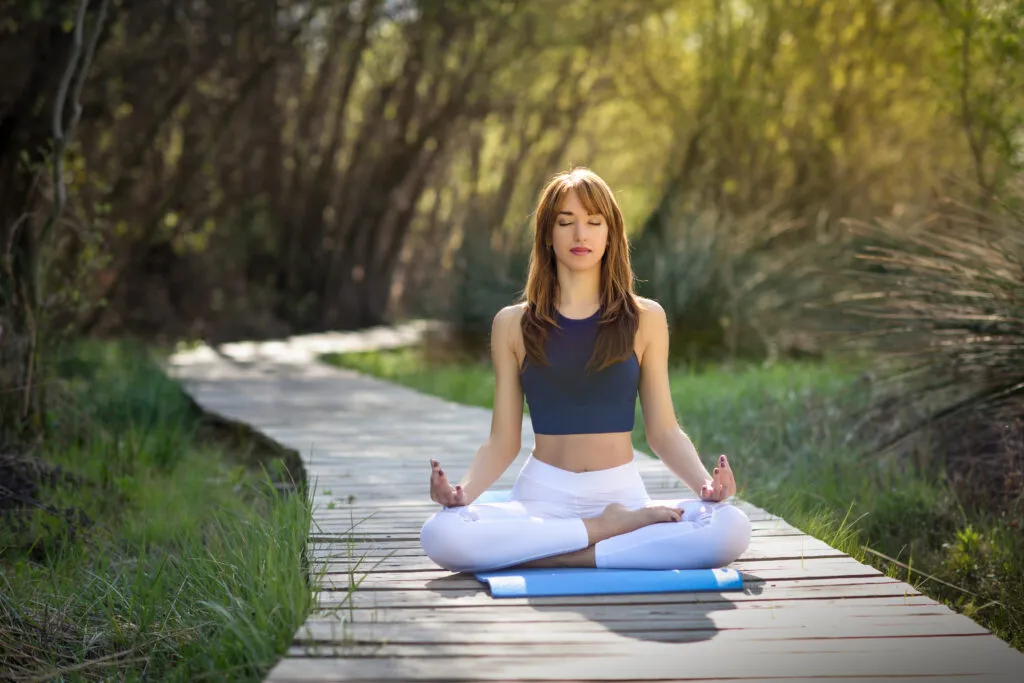Meditation Kaise Kare:
Feeling overwhelmed by the constant busyness of life? Do your thoughts seem to race at a million miles an hour? If you’re searching for a way to find inner peace the mental chatter, meditation might be the answer you’ve been looking for.
This ancient practice isn’t just about sitting cross-legged and chanting; it’s about training your mind to focus and find stillness. The good news? It’s surprisingly simple to get started, and the benefits can be profound.
Step 1: Create Your Space
Imagine a haven of calm. It can be a quiet corner in your room, a dedicated meditation space, or even a peaceful spot outdoors. The key is to find a comfortable and distraction-free environment where you can sit upright without feeling cramped.
Step 2: Find Your Comfort Zone
Now, get comfortable! Sit on a chair with good back support, a meditation cushion, or even the floor. The important thing is to maintain good posture, with your back straight but not rigid. Remember, comfort is key – you don’t want to be fidgeting throughout your session.
Step 3: Anchor Yourself with Your Breath
Close your eyes gently and take a few slow, deep breaths. Feel your chest and abdomen rise and fall with each inhale and exhale. This simple act of focusing on your breath becomes your anchor, drawing your attention inwards and quieting the mind.
Step 4: Accept the Wandering Mind
Don’t be surprised if your mind wanders. It’s natural! When thoughts pop up, acknowledge them gently without judgment. Imagine them like clouds drifting across the sky. Simply guide your attention back to your breath without getting discouraged.
Step 5: Start Small and Be Consistent
Rome wasn’t built in a day, and neither is your meditation practice. Begin with short sessions, even just 5-10 minutes. Consistency is much more valuable than length initially. Aim to meditate regularly, even if it’s just a few minutes each day.
Step 6: Explore Different Techniques (Optional)
While focusing on your breath is a popular approach, there are other ways to meditate. You could try:
- Guided meditations: Utilize apps or online resources for guided meditations with calming instructions and gentle prompts.
- Mantra meditation: Repeat a calming word or phrase silently as your focus point.
- Walking meditation: Focus on the sensations of your body as you walk mindfully, paying attention to each step.
Step 7: Reap the Benefits Beyond the Cushion
The beauty of meditation is that its benefits extend far beyond the time you spend practicing. The mindfulness and awareness you cultivate during meditation can be applied to all aspects of your life, helping you:
- Manage stress and anxiety with greater ease.
- Improve focus and concentration throughout your day.
- Increase self-awareness and understanding of your thoughts and emotions.
- Enhance your sleep quality and feel more rested.
- Develop greater emotional regulation and respond to situations with more clarity.
Remember:
Meditation is an ongoing journey, not a destination. Embrace the practice, be patient with yourself, and enjoy the sense of peace and well-being that comes with finding your inner calm.
FAQs:
How long should I meditate each day, and is there an ideal time to practice?
The ideal meditation duration varies from person to person. Beginners often start with 5-10 minutes and gradually increase. As for timing, choose a time that fits into your routine, whether it’s morning, during a break, or before bedtime. Consistency is more important than the specific time or duration.
What should I do if I find it difficult to focus during meditation?
Difficulty focusing is common, especially for beginners. When distractions arise, gently bring your attention back to your breath or chosen focal point. Acknowledge any thoughts without judgment, and over time, you’ll find it easier to maintain focus. Guided meditations or using calming music can also be helpful.
Do I need a specific meditation posture, and can I meditate lying down?
While there are traditional meditation postures, the most important factor is comfort. Sit or lie down in a way that allows you to be relaxed and alert. If sitting cross-legged is uncomfortable, sitting on a chair or cushion is perfectly acceptable. Lying down is an option, but it may lead to drowsiness for some.
Can meditation help with stress and anxiety?
Yes, meditation is widely recognized for its ability to reduce stress and anxiety. Regular practice can create a sense of calm, improve emotional well-being, and provide tools to cope with life’s challenges. Scientific studies have shown that meditation can positively impact mental health and contribute to overall stress reduction.
Must read:
What Causes Numbness in Hands While Sleeping?
Secrets of DMT Meditation: What Is DMT Meditation and How Does It Work?
Benefits of Cirkul Water Bottle for On-the-Go Hydration | 2023
Why Does Conjunctivitis Eye Infection Happen? | Pink Eye | 2023
Exploring the Exciting World of AI Technology | 2023
Top 8 Japanese Dog Breeds: A Closer Look at the Most Beloved and Iconic Breeds from Japan
Reason Behind Pollution in Delhi in Winter Season: Causes and Solutions
A Festival of Lights and Togetherness in India
Why is Quantum Computing Useful For Optimization Problems? | Reshaping Industries | 2023
Do You Know? – How to apply for overseas education loan in India
New Heights: The Race for America’s Tallest Building | 2024

